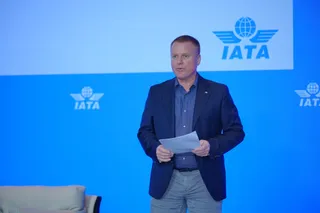Getting Out Safely
Contact Our Team
For more information about how Halldale can add value to your marketing and promotional campaigns or to discuss event exhibitor and sponsorship opportunities, contact our team to find out more
The Americas -
holly.foster@halldale.com
Rest of World -
jeremy@halldale.com

Improved training methods, sophisticated hardware and a mindset change of management is helping to evolve cabin evacuation training. Robert W. Moorman investigates.
Two aircraft accidents in recent years highlight the life and death importance of cabin evacuation training. One was the much-publicized 2009 ‘Miracle on the Hudson’, a US Airways A320 flight crew executed a near flawless landing on the Hudson River near New York City after Canada geese were ingested into both engines, taking out the power. The other accident occurred in August, 2005. An Air France A340-300 skidded off the runway after landing long at Toronto Pearson International Airport. The aircraft burst into flames after plunging into nearby Etobicoke Creek. Yet all 309 passengers and crew survived, although 43 people suffered non-life threatening injuries.
The pilots and cabin crew in both accidents were credited for their professionalism and speed in evacuating all the passengers from the aircraft. To some trainers and safety experts, these and other accidents demonstrated the need to enhance ongoing cabin evacuation training programs. To others, airline management included, the accidents demonstrated that the current method of cabin evacuation training was sufficient and that no major changes were warranted.
“That is the status quo argument,” said Candace Colander, Air Safety Coordinator with the Association of Flight Attendants. “You managed to get all of the people out. So we don’t need to change. But if we want to be forward thinking, we should ask, is there something we could do better? Yes. Are there sometimes problems with evacuating a plane? Yes,” she added.
AQP Training
Following the Hudson ditching, the US Airways training department accelerated plans to adopt Advanced Qualification Program (AQP) for flight attendants, which relies on scenario-based training. AQP allows trainers to provide more hands-on training programs as opposed to traditional instructor led training. US Airways has also adopted AQP for the recurrent training of flight attendants. In January 2013, US Airways became one of a handful of US airlines to adopt AQP training for newly hired flight attendants.
“The lessons learned from the ditching is the importance of situational awareness and being able to execute alternative procedures in handling a situation if necessary,” said Stephen Howell, director of in-flight training for US Airways.
Southwest Airlines cabin evacuation training has evolved towards an AQP-based program over the years because of organic growth and acquisition of other carriers. Southwest, like other carriers, switched from a rigid, rote learning methodology to scenario-based training.
“We’ve included a lot more situational awareness and variables for flight attendants to assess and make choices, and change evacuation techniques to fit various scenarios,” said Larry Parrigin, development manager for In-flight Training. “We want them to use the appropriate commands for the appropriate circumstances.”
The safety and emergency training program for newly hired Southwest flight attendants is about a week. The evacuation-training portion is spread out over three days and includes land and water ditching evacuation. The full initial training program for flight attendants lasts around five weeks. Southwest began cabin evacuation water ditching training in February 2013 after announcing new international flights. [The FAA requires airlines to carry life rafts for all flights that exceed 162 miles.]
All the airlines which CAT interviewed said they developed training scenarios which focus on unplanned emergencies, much like what happened on the Hudson River. In that emergency, a flight attendant blocked one rear exit because water had crept above the door bus line. She turned the passengers toward another passable exit. US Airways now runs AQP-based scenarios where instructors block a door because it is impassable due to water, fire or debris.
For many years, JetBlue Airways’ evacuation drills began with a cue and crewmembers became conditioned to those cues. But trainers discovered that as they introduced variations to evacuation drills, the crewmembers occasionally had “difficulty getting away from the drills they had learned by rote,” said Thomas Kaminski, manager In-flight Training Program Development. “Now we allow the conditions and contingencies to dictate the cues during a drill, and our crewmembers have become accustomed to expect those variations.”
Under the AQP umbrella, the emphasis on training has shifted from expecting “picture perfect, verbatim responses” to more realistic training conditions and responses, said Kaminski.
JetBlue pilots receive evacuation training adapted from the flight attendant program and is taught by flight attendants. When scheduling allows, JetBlue pilots and flight attendants conduct wet ditching evacuation training together.
Handy Hardware
The airlines use a variety of aids for cabin evacuation training. Howell said US Airways takes a “blended approach” to flight attendant initial and recurrent training at centers in Charlotte, North Carolina and Phoenix, Arizona. They utilize cabin door and next generation cabin emergency evacuation trainer (CEET) devices at both sites. During training, cabin crews spend around “80% of the day onboard the trainers,” which is a significant jump from years past, he added.
Flexibility is the key to all phases of cabin training, including evacuation instruction. And computer based training is helpful, up to a point. US Airways places its Continuing Qualification Training recurrent home study guide online, a six-hour course that flight attendants must complete prior to showing up for their annual recurrent training.
Southwest said the cost of placing advanced CEET and sophisticated cabin door trainers at the nine training centers is prohibitive. So the airline provides basic door trainers, without the bells and whistles, at the sites. Southwest has one advanced CEET, half the size of a B737-300 cabin, at its Dallas headquarters. The CEET, manufactured by Safety Training Systems of Tulsa, Oklahoma, comes equipped with smoke, fire, motion (roll and pitch) and sound.
JetBlue University in Orlando, Florida, which trains pilots and flight attendants, employs several door trainers. JetBlue will soon acquire an advanced door trainer built by EADS RST, Rostock System-Technik based in Germany. The door trainer simulates the 3 left and 3 right door pair.
Airlines examine accidents and incidents industry wide typically to enhance their scenario based evacuation-training programs. They also apply lessons learned from accidents in which they’ve been involved to their evacuation training programs.
One accident occurred in July, 1996. A Southwest 737 overran the runway at Nashville International Airport after an aborted takeoff. Flight attendants initiated an emergency evacuation when the aircraft came to rest without alerting the pilots. It was learned later than an emergency evacuation was not warranted.
“This was a great example of where communication between the cabin and flight deck needed improvement,” recalled Parrigin, adding that the accident marked the start of Southwest’s current CRM and threat and error management programs.
Additional improvements to Southwest cabin evacuation training came from two other runway overrun accidents that prompted evacuations. One occurred March, 2005 at the Burbank-Glendale-Pasadena Airport. Southwest Flight 1455 overran the runway after landing fast and came to rest in the street near a gas station. Parrigin said there were “multiple issues with that evacuation” that could be used in training programs. Some equipment malfunctioned and a few exits weren’t available.
Another overrun accident Southwest uses occurred December, 2005 at Chicago Midway International Airport. Southwest Airlines Flight 1248 slid off the runway after landing in a snowstorm and crashed into automobile traffic, resulting in the death of a six-year-old boy.
Whilst a valuable training tool, JetBlue’s Kaminski cautioned against adopting lessons learned in evacuation training without careful examination. Best practices as they relate to evacuation training are “hotly debated,” said Kaminski. “We are very careful in training when discussing or enforcing best practices unless they specifically support good threat and error management. You always need to keep an eye on best practice that can lead to procedural drift.”
Training Devices
Helping trainers’ replicate this real life like environment in cabin evacuation training are various hardware and software training aids. Leading the pack are next generation door and CEET trainers.
In addition to the training solutions giants, CAE and FlightSafety International, there are other manufacturers of training devices worth noting.
EDM Ltd. produces numerous sophisticated door trainers for Airbus and Boeing aircraft, including the A340, A320, B737 and B787, and advanced CEET systems. Its latest product is SEPTRE, which stands for Safety and Emergency Procedure Training Reality Engine. SEPTRE is a PC-software based system that provides motion, digital sound and visual cuing for CEETs. It is a modular design system that simulates various pre-programmed training scenarios, such as engine fire, turbulence, ditching and aborted takeoff.
“If an airline can’t afford a new CEET, we can offer SEPTRE as an upgrade to an existing trainer,” said EDM Sales Director Mick Bonney. EDM has delivered eight SEPTRE systems to China airlines mostly, including Air China and Hainan Airlines. China requires that all CEETs have motion systems and EDM recently built a motion equipped A330 widebody CEET for Air China. The company claims to be the first training device provider to design and manufacture a CEET for the B787 Dreamliner. It is supplying Continental Airlines with a CEET for its new Dreamliner fleet.
Aviation Reproduction Inc. (ARI) is another leader in manufacturing door and elaborate CEET trainers for commercial and business aircraft. At present, the Mississauga, Ontario-based company’s products vary from a standalone door trainer and door trainer with cabin space to full cabin trainer as long as 43 feet, some with a cockpit included. For full cabin trainers, instructors are able to control the lesson plans with a touch screen, or from anywhere in the cabin via a tablet or smart phone.
ARI is delivering a Bombardier Dash 8 Q400 commercial cabin trainer to Westjet Airlines, and a corporate Gulfstream Corporate Cabin Trainer to FlightSafety International in Savannah. The Gulfstream trainer is able to train for multiple configurations, such as the Gulfstream Legacy and G650. In addition to a lavish interior, the corporate trainer includes fire and smoke, 3D visuals and full motion.
Sim-Tech Manufacturing of Fayetteville, Georgia produces standalone door trainers and CEETs. Sim-Tech’s clients include TACA, United Airlines, Delta Air Lines, Qantas and Air Tran Airways. The lean company is somewhat unique in that it builds CEET trainers from scratch, but also refurbishes actual fuselages and exit doors for training, in what the Sim-Tech President Dan Conrey calls “repurposing.” Seventy-percent of Sim-Tech’s business is producing door trainers.
Safety Training Systems, Inc. specializes in designing and building cabin training devices along with training devices for other aviation related disciplines. Founded in 1978, this woman-owned small business is capable of designing training devices to detailed customer specifications.
RST Rostock System-Technik GmbH, an EADS company, allied to Airbus, supplies door and evacuation trainers for various commercial aircraft. RST was selected to design and manufacture the first two door trainers for the Airbus A350, which recently made its inaugural flight.
Spatial Composite Solutions supplies cabin training simulators and is the only one based in the Middle East. The company supplied cabin, CEET, door trainers to numerous carriers, including Virgin America and Virgin Blue in Australia.
RP Aero Systems, part of the RP Group, designs and manufactures cabin crew training systems, including CEET trainers that come with fire and smoke simulation and cabin communication systems. Aer Lingus, Air Asia, Air Canada and British Airways are among their customers. RP Aero’s B787-door trainer recently went into service at the BA Training Center, Cranebank, UK.
Software
Software is key to producing realistic cabin door and evacuation trainers. LIVINGSOLIDS GmbH, a German-based maker of virtual reality software, is one such company. LIVINGSOLIDS software can replicate a 3D model of any technical device, which is especially helpful in flight and cabin training.
Photo Concept AB’s Virtual eTraining Software, which demonstrated its cabin crew recurrent training applications at WATS 2013, is another software maker worth noting because its 3D tools ARE becoming an integral part of cabin crew training, including cabin evacuation training. The interactive-based 360-degree image technology has been around since 2008, but only recently began marketing it to airlines as a training tool. Norwegian Air Shuttle is the launch customer for the virtual training module for airlines. The walk around experience in the 3D virtual cabin is a principal benefit of the technology. Photo Concept AB is developing a network of partnerships with training centers and flight academies, according to Örjan Persson, head of sales.
UPS Evacuation Plans
United Parcel Service doesn’t carrier passengers, at least not human ones. But it has enhanced emergency procedures and added safety equipment for its flight crewmembers. UPS pilots drill annually on slides, rafts and related procedures as part of its regular training programs.
“Where we’ve innovated in the last two years is in preventing a crisis before it happens,” said UPS spokesman Mike Mangeot. “We have taken several industry-leading steps on smoke in the cockpit and in fire mitigation on the cargo deck.”
UPS claims to be the first international carrier to implement the Emergency Vision Assurance System (EVAS). EVAS is essentially an inflatable “bubble” that displaces the smoke and allows pilots to maintain a view of instruments and out the window. On the cargo deck, UPS is implementing fire containment covers for palletized cargo and is researching fire-resistant containers. These unit load devices (ULDs) can contain a 1,200-degree fire for up to four hours, said Mangeot, giving pilots additional time to divert to an alternative-landing site in case of emergency.
UPS trainers say the enhancements procedures and new equipment is unrelated to the September 3, 2010 crash of a UPS B747-400 near Dubai. Investigators said a fire in a large shipment of rechargeable lithium ion batteries was the probable cause of the crash.
ICAO Rewrites Manual
The International Civil Aviation Organization (ICAO) is in the process of rewriting its Cabin Crew Safety Training Manual with the focus on competency-based training.
ICAO formed the Cabin Safety Group in January 2012 to rewrite the manual. The group, which is made up of industry and regulatory leaders, is developing guidance material to support implementation of ICAO Annex 6, Part 1 (International Operations) training requirements for cabin crew.
“We have spelled out in the manual what evacuation should include,” said Martin Maurino, technical safety officer with the Air Navigation Bureau, ICAO. The rationale behind the rewrite is “to ensure that the cabin crew is proficient to perform their duties and establish an international baseline no matter what cultural differences are in the mix,” he said.
The manual will include guidelines for safety and emergency procedures training. Guidance includes practicing skills required during evacuation, such as communication, teamwork and leadership, error recognition and management, workload and time management and decision-making.
There is also guidance for hands-on exercise on assisting evacuation means, such as slide, slide-raft, life raft and ropes. Training also addresses crowd control and management of the cabin situation. This includes giving appropriate instructions to passengers for evacuation.
Work on the 12-chapter manual will be complete by the end of 2013, Maurino said. Carriers and interested parties can obtain an unedited copy once complete. The manual will then be polished and released formally in mid-2014.


